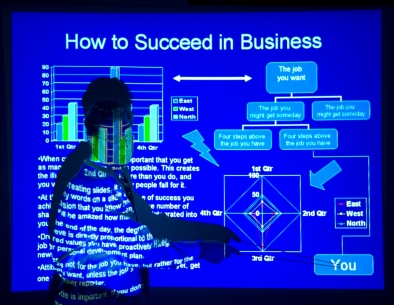Public Speaking Body Language Part Seven: Powerpoint
This is the seventh article in an eight-part series covering the most important elements of body language for public speaking. Click here to read the entire series.
Years ago, I worked a trainee who presented her practice speech in the usual way, with her PowerPoint presentation projected onto a screen behind her.
What was unusual was the way she interacted with her slides. She must have snapped her neck from the audience to the screen once per second. I’ve never seen anything like it. Her frequent neck snaps reminded me of a chicken.
To get her to break the habit, I blacked out the screen and asked her to present with nothing behind her. The result was stunning: She suddenly appeared confident and, for the first time, connected with her audience. It was like watching an entirely different person.
Although her case was extreme, the underlying problem isn’t.

When people present with a screen behind them, they often present with their bodies angled halfway in between the screen and the audience. That’s because of something I call “PowerPoint foot.” Subconsciously, we position our feet in the direction we want to go. If we know we want to look at the screen, we’re going to position our feet at least partially away from the audience, in the direction of the screen.
When presenting a PowerPoint slide, your feet should almost always face the audience. When you present a new slide, you might walk toward the screen to point to something specific for a moment or two – but aim for squaring your shoulders off with the audience at least 98 percent of the time.
When presenting material on the screen, stand to the right of the screen (the audience’s left). Since people read from left to right, you will allow the audience to use their natural eye movements when moving from you, across the screen, and back to you.
Click here to read the entire series, which covers energy, tone, eye contact, gestures, posture, where to stand, how to interact with PowerPoint, and voice.
My new book, 101 Ways to Open a Speech, is now available at Amazon. You can read more about the book here.


